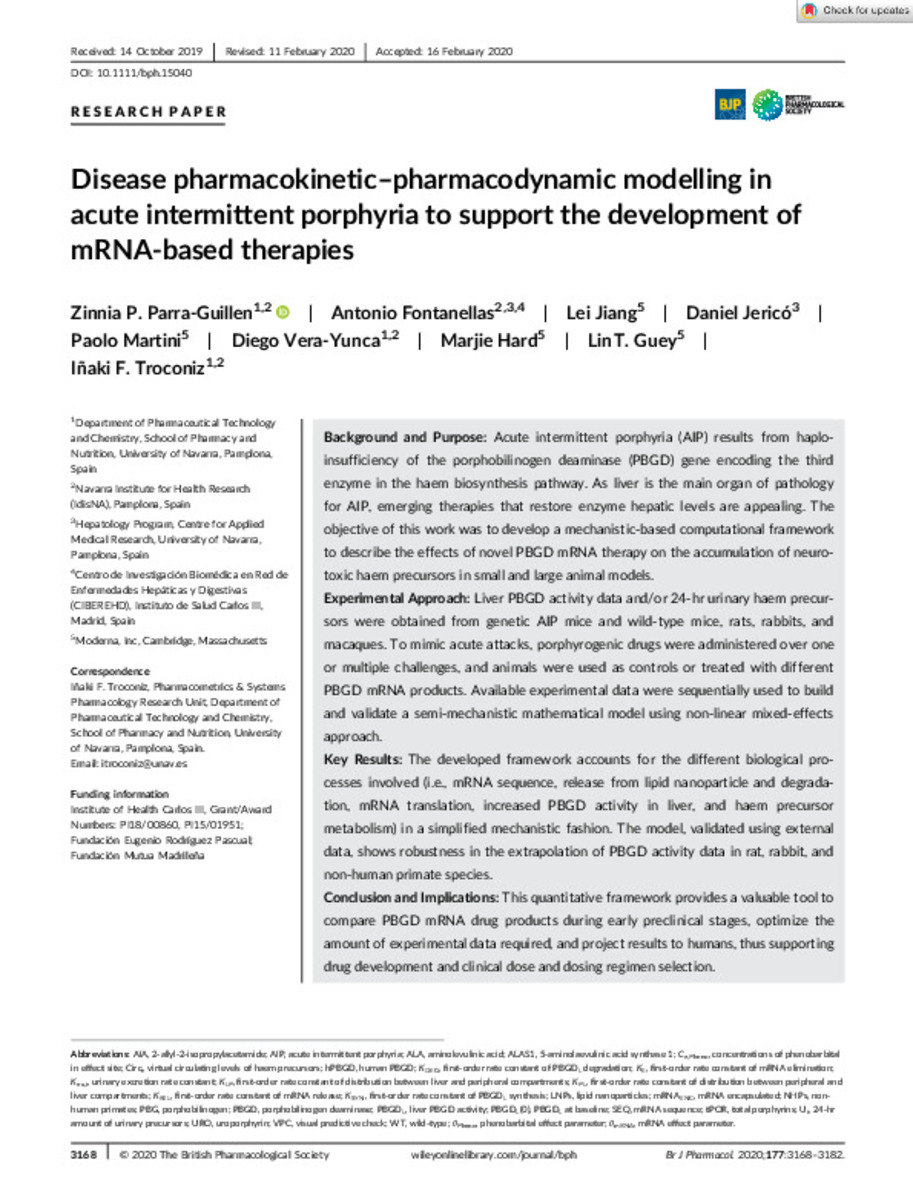Full metadata record
| DC Field | Value | Language |
|---|---|---|
| dc.creator | Fernández-de-Trocóniz, J.I. (José Ignacio) | - |
| dc.creator | Parra-Guillen, Z.P. (Zinnia Patricia) | - |
| dc.creator | Fontanellas-Romá, A. (Antonio) | - |
| dc.creator | Jericó-Asenjo, D. (Daniel) | - |
| dc.creator | Martini, P. (Paolo) | - |
| dc.creator | Vera-Yunca, D. (Diego) | - |
| dc.creator | Hard, M. (Marjie) | - |
| dc.creator | Guey, L. T. (Lin) | - |
| dc.creator | Jiang, L. (Lei) | - |
| dc.date.accessioned | 2024-01-17T11:57:21Z | - |
| dc.date.available | 2024-01-17T11:57:21Z | - |
| dc.date.issued | 2020 | - |
| dc.identifier.citation | Fernández-de-Trocóniz, J.I. (José Ignacio); Parra-Guillen, Z.P. (Zinnia Patricia); Fontanellas, A. (Antonio); et al. "Disease pharmacokinetic–pharmacodynamic modelling in acute intermittent porphyria to support the development of mRNA-based therapies". British Journal of Pharmacology. 177 (14), 2020, 3168 - 3182 | es_ES |
| dc.identifier.uri | https://hdl.handle.net/10171/68393 | - |
| dc.description.abstract | Background and Purpose Acute intermittent porphyria (AIP) results from haplo-insufficiency of the porphobilinogen deaminase (PBGD) gene encoding the third enzyme in the haem biosynthesis pathway. As liver is the main organ of pathology for AIP, emerging therapies that restore enzyme hepatic levels are appealing. The objective of this work was to develop a mechanistic-based computational framework to describe the effects of novel PBGD mRNA therapy on the accumulation of neurotoxic haem precursors in small and large animal models. Experimental Approach Liver PBGD activity data and/or 24-hr urinary haem precursors were obtained from genetic AIP mice and wild-type mice, rats, rabbits, and macaques. To mimic acute attacks, porphyrogenic drugs were administered over one or multiple challenges, and animals were used as controls or treated with different PBGD mRNA products. Available experimental data were sequentially used to build and validate a semi-mechanistic mathematical model using non-linear mixed-effects approach. Key Results The developed framework accounts for the different biological processes involved (i.e., mRNA sequence, release from lipid nanoparticle and degradation, mRNA translation, increased PBGD activity in liver, and haem precursor metabolism) in a simplified mechanistic fashion. The model, validated using external data, shows robustness in the extrapolation of PBGD activity data in rat, rabbit, and non-human primate species. Conclusion and Implications This quantitative framework provides a valuable tool to compare PBGD mRNA drug products during early preclinical stages, optimize the amount of experimental data required, and project results to humans, thus supporting drug development and clinical dose and dosing regimen selection. | es_ES |
| dc.description.sponsorship | Fundación Eugenio Rodríguez Pascual; Fundación Mutua Madrileña | es_ES |
| dc.language.iso | spa | es_ES |
| dc.relation | PI18/00860; PI15/01951 | es_ES |
| dc.rights | info:eu-repo/semantics/openAccess | es_ES |
| dc.subject | Porphyria | es_ES |
| dc.subject | Porphobilinogen deaminase | es_ES |
| dc.subject | mRNA-based therapies | es_ES |
| dc.subject | 2-allyl-2-isopropylacetamide | es_ES |
| dc.subject | Aminolevulinic acid | es_ES |
| dc.subject | Uroporphyrin | es_ES |
| dc.title | Disease pharmacokinetic–pharmacodynamic modelling in acute intermittent porphyria to support the development of mRNA-based therapies | es_ES |
| dc.type | info:eu-repo/semantics/article | es_ES |
| dc.relation.publisherversion | https://bpspubs.onlinelibrary.wiley.com/doi/10.1111/bph.15040 | es_ES |
| dadun.citation.endingPage | 3182 | es_ES |
| dadun.citation.number | 14 | es_ES |
| dadun.citation.publicationName | British Journal of Pharmacology | es_ES |
| dadun.citation.startingPage | 3168 | es_ES |
| dadun.citation.volume | 177 | es_ES |
Files in This Item:
Statistics and impact
Items in Dadun are protected by copyright, with all rights reserved, unless otherwise indicated.






